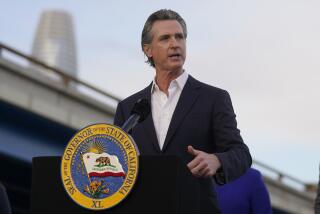Help for Transit
- Share via
California has been giving highways first claim to tax money and handing what’s left to mass transit. Now several of the state’s urban areas, led by Los Angeles, are starting to pay dearly for that policy.
Anyone who works in or near downtown Los Angeles is acutely aware of the increasing outbreaks of traffic gridlock in the central business district. In some of the commercial centers on the Westside, along Ventura Boulevard and in Orange County people are riding the brakes because too many cars are crammed into narrow surface streets and onto freeways.
Last week public transit officials from throughout the state were in Sacramento urging Gov. George Deukmejian and the Legislature to put more money into mass transit before the state economy is adversely affected by a “crisis in urban mobility.” They warned that the state gas-tax subsidies received by bus systems like the Southern California Rapid Transit District and subway operators like Bay Area Rapid Transit are shrinking because of falling gasoline consumption. When combined with cutbacks in federal transit subsidies proposed by the Reagan Administration for the coming fiscal year, the financial losses could leave the state’s public bus and rail systems with a budget shortfall of more than $400 million by 1988. Such losses could be made up only by cutbacks in services and massive fare increases that would force many transit riders into private cars, increasing the threat of gridlock in cities from Sacramento to San Diego.
Transit officials calculate that a 1-cent-a-gallon increase in the state gasoline tax, currently 9 cents, and allocation of a fraction of the state sales tax would raise the $400 million that they need. That is a most modest request. So reasonable, in fact, that it doesn’t go nearly far enough.
A better idea is state Senate Bill 290, introduced by Sen. John F. Foran (D-San Francisco). Foran would raise the state tax by 5 cents per gallon and divide the money between state and local governments for construction and maintenance and for transit projects, such as bus guideways on freeways and more light rail in the fashion of the San Diego-Tijuana trolley. The bill would also set aside $250 million per year from sales-tax revenues for local agencies to use where it was most needed, for operating subsidies or capital improvements.
The biggest roadblock, so to speak, for SB 290 appears to be Deukmejian’s determination not to raise state taxes of any kind. In the case of the gasoline tax he should make an exception. Not only would a gas-tax increase provide more money to finish freeway and mass-transit projects already under way, but it also could provide seed money to launch new transit projects that might otherwise die as a result of the Reagan Administration’s shortsighted budget cutbacks. Projects in jeopardy include Los Angeles’ Metro Rail subway and a light-rail system being planned for San Jose.
Deukmejian has spoken often and eloquently about his desire to improve the business climatein California. A key aspect of a good business climate is the ability of workers to get to andfrom their jobs easily. SB 290 would be a good first step in that direction, and the governor and the Legislature should give it their wholehearted support. Mass-transit projects are major undertakings. They require not just planning ahead but also thinking ahead.
More to Read
Sign up for Essential California
The most important California stories and recommendations in your inbox every morning.
You may occasionally receive promotional content from the Los Angeles Times.













